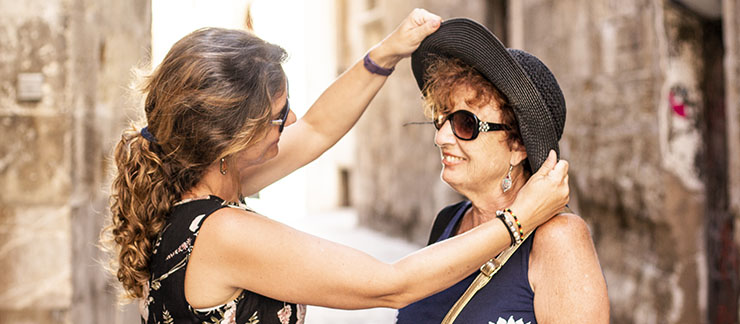
How to Spot and Help Prevent Skin Cancer in Seniors
When spring finally comes around after a long winter, it’s important to keep sun safety in mind for aging seniors. The ultraviolet (UV) rays in sunlight can easily damage their sensitive skin.
Skin cancer is the most commonly diagnosed cancer in the U.S. In fact, the number of skin cancer diagnoses each year is more than all other cancers combined. Most cases are detected in adults older than 65.
The good news is that most types of skin cancer are treatable if they’re caught early. Family caregivers can help protect seniors against harmful sun exposure with a little knowledge and planning.
Facts About Skin Cancer and Aging
Damage from sunburn and tanning builds up as we age, leading to abnormal activity in skin cells that can turn into cancer. Individuals who work outdoors are most at risk.
As we age, our skin becomes thinner, more brittle, and more susceptible to UV damage. We also cannot regulate body temperature, so seniors might not be able to sense when they’ve been in the sun too long. Some medications also make the skin more sensitive to sunlight. Talk with your loved one’s doctor and pharmacist about their skin cancer risk.
Watch for Signs of Skin Cancer
Skin cancer in seniors often goes undetected or overlooked. Freckles, moles, age spots, and other skin changes can mask potential problems, so it's important to watch for changes.
Everyone who provides care for a senior should become familiar with the warning signs of skin cancer. Follow the “ABCDE” guidelines from the American Cancer Society to detect possible signs of skin cancer:
- Asymmetry
- Border
- Color
- Diameter
- Evolving
Your senior’s medical checkups should include a full-body visual assessment. The Skin Cancer Foundation recommends head-to-toe self-examination once a month and an annual visit to a dermatologist for a professional total-body exam. Encourage your loved one to talk openly with their doctor about lifetime sun exposure and the need for closer screenings.
Tips to Protect Your Senior’s Skin
Though sun damage is cumulative, every preventative step can help reduce the risk of developing skin cancer at a later age. Follow these tips to help protect your senior from the sun’s rays:
- Apply sunscreen: Choose a product with a sun protection factor (SPF) of 30 or greater. Sunscreen should be reapplied every two hours. If you use a spray-on sunscreen, rub it in for maximum coverage.
- Avoid peak UV exposure times: Stay in the shade between 10 a.m. and 3 p.m. This guideline holds true no matter the temperature. Don’t be fooled by clouds—even dense clouds only block about 50% of UV rays.
- Keep covered: Seniors should wear long pants and long sleeves made of a lightweight material, closed shoes, or socks with sandals.
- Wear a hat: Up to 95% of skin cancers occur on the head and neck—areas we often miss with sunscreen. Men and women with thinning hair or bald spots are especially vulnerable to sun damage on the scalp. Ask them to wear a lightweight or straw sun hat with breathability and a full brim to shade the forehead, ears, and neck.
- Protect the eyes: Well-fitting sunglasses will protect the delicate skin around the eyes, reduce eye strain, and lower the risk of developing cataracts.
How Professional In-Home Care Can Help
That’s a lot of steps to remember to enjoy fun in the sun this summer. Visiting Angels professional caregivers have your back.
We can help remind your aging loved one to follow sun-safety recommendations and assist with dressing appropriately and applying sunscreen before enjoying favorite outdoor activities such as gardening, outdoor concerts, or walks in the park.
Contact your local Visiting Angels home care office for a free, no-obligation consultation today.


